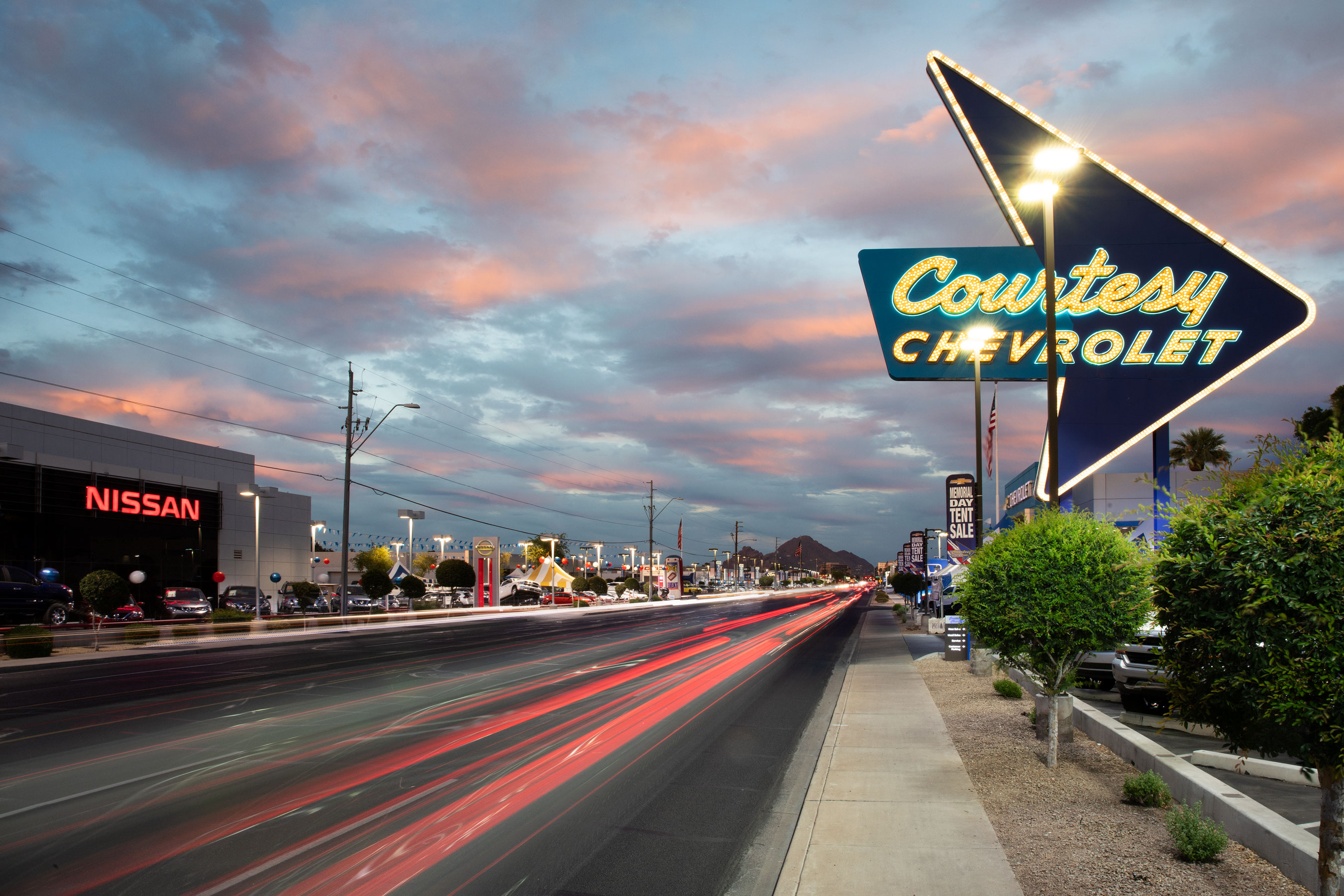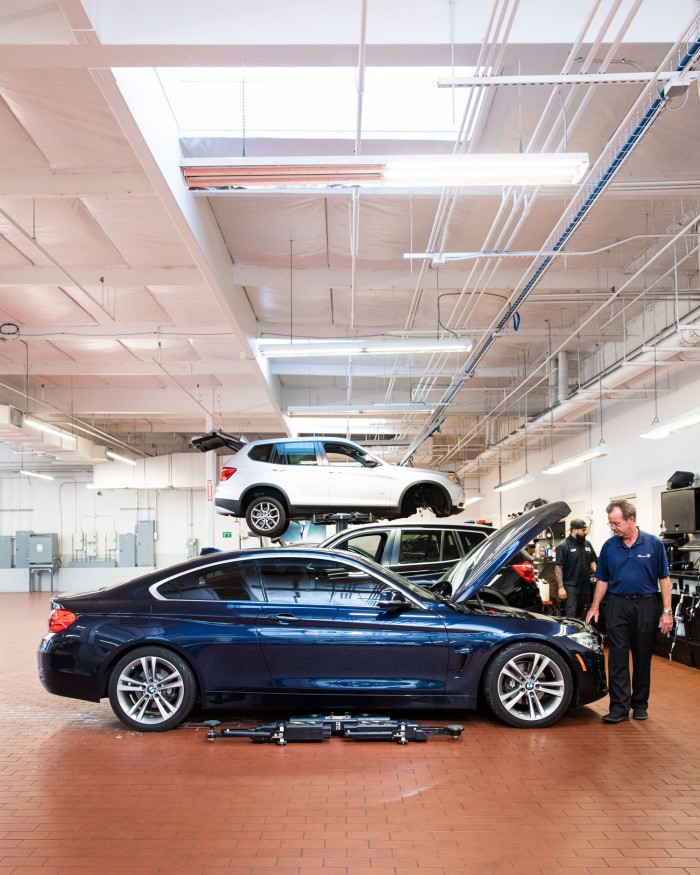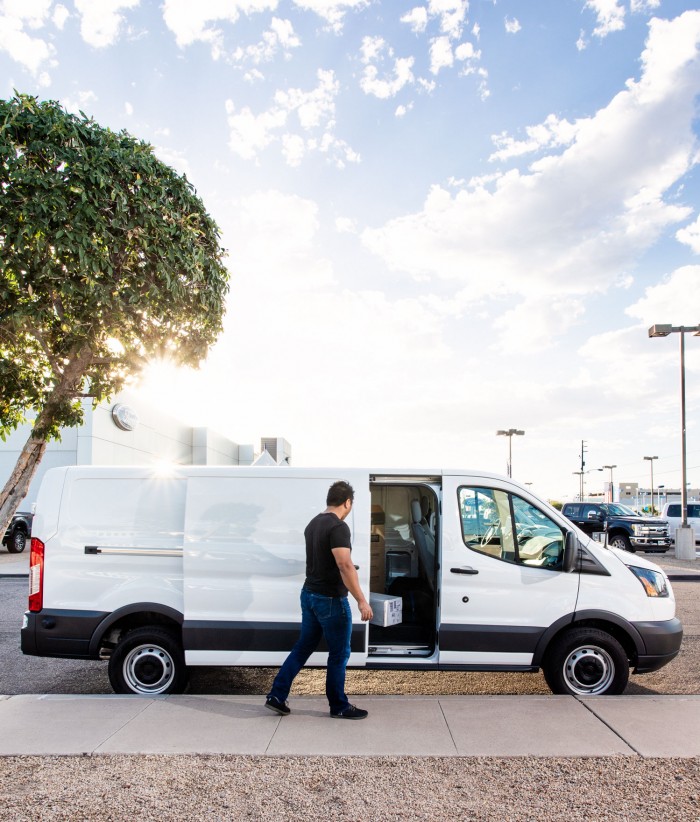Phoenix will no longer be Phoenix if Waymo’s driverless-car experiment succeeds

The car cult
Sitting in the BMW dealership waiting for a flat to be replaced, I realize I’ve driven over 100 miles and spent five hours behind the wheel this week. And it’s only lunchtime on Wednesday. In Phoenix, I am living the life this city has designed for me.
A sprawling grid fueled by swooping highways and generous arterial roads, the Phoenix metropolitan area is a gargantuan expression of the car culture that defines the urban experience for most Americans. To use this space, you need a vehicle. Anything else effects your passive or active exclusion from a host of activities and, more broadly, from the culture itself. You might choose to live downtown in one of the few patches of walkable urban space, but your access to groceries, drugstores, and other amenities will be severely limited. To meet friends, to send children to school, to attend a concert or a movie, is to buy into car culture and its attendant traffic jams, parking-space hunts, and maintenance responsibilities for a vehicle that is expensive to purchase and rapidly loses value.
Camelback Road, one of those major arteries, is a 33-mile temple to this cult of the car. Dealerships, auto repair shops, strip malls, and car washes, all ringed by vast parking lots, line a six-lane roadway that is deeply discouraging to navigate by foot. This world was designed by well-meaning urban planners, business owners, politicians, and private citizens who thought they were building the spaces where prosperity would grow, with the personal automobile as its driving force.

But Camelback is also ground zero for what may become the biggest disruption to cars’ place in American life since they were invented. Thanks to Arizona’s hands-off approach to regulation, firms developing self-driving cars—many of them headquartered in neighboring California—have begun to do their testing in the state.
Much of the debate has focused on safety, particularly after a self-driving Uber vehicle knocked down and killed a pedestrian in Tempe in March. Yet safety is only the first question. After all, if vehicular deaths were our primary concern, we might have banned cars from urban roads long ago; Arizona itself leads the nation in its rate of pedestrian fatalities.
Rather, as autonomous-vehicle companies continue testing and lobbying, we will find ourselves redesigning society to accommodate that technology in ways that go far beyond safety. Autonomous vehicles won’t merely eliminate the need to hold a steering wheel. They will enable entirely new modes of transportation and vehicle management that could accelerate the decline in private car ownership. What will then become of the rich ecosystem of infrastructure, services, retail, and cultural experience that has grown up around automobiles? What happens to Phoenix and hundreds of similar cities when we reinvent the car?
Sharing the future
It’s already possible to book a ride in a Waymo vehicle with no human behind the steering wheel. That won’t just take work from human Lyft and Uber drivers; it will change life for millions of travelers in these cities.
That’s because these cars will be not just driverless but also probably ownerless, at least in the customary sense. Waymo appears to be aiming squarely at a shared-transportation model. Its vehicles will operate in fleets (Waymo has already partnered with Avis to service and maintain its test vehicles in Arizona) as autonomous taxis. CEO John Krafcik described the company’s vision in December: a small fleet of self-driving cars could serve an entire community because “you’re accessing vehicles rather than owning them.” A study envisioning such a fleet of vehicles at work in a simulated city based on Austin, Texas, found that running the network would cost about as much per mile as individual car ownership, and possibly less.
For Phoenix today, the most radical change in this future will be the nature of the car itself. Krafcik argues that cars “no longer have to be designed around the driver as the primary user.” Instead you might step into a Starbucks Van, or a Burger King Coupe, to dine and commute at the same time. This could spell the end of drive-throughs like the Dutch Brothers coffee franchise, whose euphorically hands-on customer service seems to be irresistible to the millennial drivers who queue up tens of cars deep at the Camelback location.

In this vision of a shared-mobility future, the changes would ripple up and down thousands of streets like Camelback. The nearly trillion-dollar US auto industry may very well have to reinvent itself as cars evolve from consumer objects at rest an estimated 95 percent of the time to workhorses overseen by fleet management algorithms tasked with maximizing the value of every mile. Some companies would start offering cheaper ride-share services using no-frills vehicles designed for many years of continuous use.
If fewer people buy cars, many of the glittering auto showrooms on Camelback might close. Ford has announced that it will sell only two models of sedan going forward, concentrating on SUVs and trucks instead. But if oil prices rise, economics and physics may conspire to push people away from SUVs and further toward a shared model. Ford is “radically changing their ideas about cars” to accommodate a near future of selling car-related services rather than the cars themselves, says Larry Goldberg, a cofounder of the futures consultancy Experimental Design, which has been working with Ford and other industry players.
The phrase “mobility as a service” weaves together the business models of ride-sharing companies, the ambitions of manufacturers like Ford and Tesla, and the broader turn to a service economy. Cars may increasingly come to resemble smartphones—not just lumps of hardware, but consumer experiences that we pay monthly fees to use, and whose functions can be changed remotely by software updates, as Tesla already does with some cars. As more cars become autonomous, they’ll drive to where they’re needed and schedule their own maintenance checks, taking these decisions out of the hands of the consumer and entrusting them to corporate software. All that code will funnel the currently vibrant ecology of auto-related businesses, from windshield replacement and custom detailing to mechanics, tire dealers, and parts retailers, into an increasingly narrow set of corporate fiefdoms and centralized systems of control.
Changing the car economy
Consider the car wash, a mainstay of urban life in the dusty Southwest. A Waymo vehicle cannot go through a normal car wash for fear of damaging its many sensors. Instead the company’s agreement with Avis includes specialized hand-washing.
The ripples of a changing car culture have already reached the local Jacksons Car Wash chain. At the Jacksons a block off Camelback at 20th Street, attendants in matching T-shirts vigorously towel off glossy cars as usual while a conveyor belt moves other vehicles through a noisy array of rotating brushes, sprayers, and mops. But there is also a banner celebrating a partnership with Uber. Its drivers can get discounted services and even subscriptions for unlimited car washes—essential when having a dirty car can cost a driver a five-star rating.

Jacksons is already upgrading its conveyor belts to safely handle Teslas, with their sensors and battery packs, and it is watching the evolution of autonomous vehicles closely. Sean Storer, the company’s senior vice president, predicts that if they’re individually owned, demand will grow for “full service” washes with hand toweling and customized human attention. But if Waymo, Lyft, or Uber owns them, the companies may see more profit in creating their own facilities where cars can be recharged, cleaned, serviced, and detailed all under one roof.
Variations on that prospect multiply as you move up and down Camelback. Alan Gershenfeld, a cofounder of Experimental Design, envisions a host of services for autonomous vehicles. Small companies might customize them for the specialized needs of landscapers or plumbers, for example, or to comply with a city’s local regulations.
“The companies that adapt will thrive. But there will be pain in the transition,” Gershenfeld says. Automation is likely to eliminate or transform over a third of the jobs in Phoenix, according to a recent report from the New America Foundation and Burning Glass, a labor-market data company. Transportation will account for a lot of them. These jobs are the lifeblood of Camelback Road: retail and services, stockers and servers, drivers and cashiers, all dependent in myriad ways on the current ecosystem of private cars, parking lots, and drive-up retail.
And that’s not where the economic disruption ends. Many people now turn to Lyft, Uber, and the gig economy to make ends meet if they lose full-time employment. The automation that eliminates jobs along Camelback might also take part-time driving off the table, notes Megan Garcia, head of New America’s recently launched Phoenix outpost. Already, contractors working for Waymo have taken to the employment reviews site GlassDoor to complain about poor working conditions, thwarted even from complaining to Waymo’s HR because they are hired through intermediary companies. Waymo declined to comment.
Blame it on the youth
Self-driving cars aside, Storer of Jacksons Car Wash says what really worries him is generational change. Younger people are, in growing numbers, rejecting not just car ownership but even the once-mandatory rite of passage that is getting a driver’s license. When they do buy cars, they don’t care as much about washing, maintenance, or detailing.
However, this kind of cultural revolution—a rejection of the car as a central facet of American identity—could also present tremendous opportunities. The same forces leading sleek new condos and cafés to sprout up in downtown Phoenix could redirect the vast amounts of time, energy, and cash we put into the car cult toward a different kind of urban experience.
Cars may be privately owned, but the infrastructure they rely on is largely public: sidewalks and streets, traffic lights and parking requirements. Motivated city governments can legislate change: London, New York, and Barcelona, for example, have restricted or outright banned vehicles from certain areas. Widespread vehicle sharing would eliminate the need for most parking structures. All this can free urban space for parks, pedestrian shopping districts, housing, or urban farms. That could increase property values and create new local economies.

This is already starting to happen. San Francisco is nearly a decade into an experiment that lets local businesses convert parking spaces into “parklets” instead. In Arizona the city of Chandler, which has been working closely with Waymo, will let zoning authorities reduce parking space by up to 40 percent in anticipation of autonomous vehicles. If Waymo is even modestly successful in promoting shared transit, it should mean fewer vehicles and less urban congestion. Chandler’s mayor, Jay Tibshraeny, argues that the changes will expand “the amount of property available for revenue-generating activity.” And it is tantalizing to imagine a Phoenix that is greener, less polluted, less congested, and consequently less of a baked-concrete inferno six months of the year.
It is an inspiring vision. But there are good reasons why the only cities that have taken major steps toward it have densely packed urban cores. The fate of Phoenix as a temple to the car may have already been sealed by 60 years of concrete, bypasses, and car-oriented urban design.
Pry the steering wheel from my cold dead hands
It may also have been sealed by personal choices. Phoenicians might simply refuse to abandon their vehicles because they’ve invested too much already: the cars, the generous garages, and all the equipage that goes with them. Not to mention the defining choices they have made about neighborhoods, school districts, commuting, friendships, and relationships—the whole fabric of work and life, dictated by cars and the urban layouts needed to travel in them.
That’s why, while Waymo is banking on a future of shared-vehicle fleets, plenty of car companies aren’t giving up on private ownership. Elon Musk foresees a Tesla Network, a “shared autonomy fleet” in which car owners can rent their vehicles out to others on their own terms—restricting access to friends and family, for example, or to certain hours of the day.
Phoenicians might refuse to abandon their vehicles because they’ve invested too much already: the cars, the garages, not to mention the defining choices they’ve made about neighborhoods, school districts, commuting, friendships, and relationships—the whole fabric of work and life, dictated by cars.
David King, an urban planner at Arizona State University, suggests that automation could even make private vehicle ownership more valuable. “What if my car takes me to work and then runs my errands for me?” he says. “You know what’s used even less than 5 percent of the time? My toilet. There’s a utility to having it there.” King’s point is that we are willing to pay for the perk of owning a vehicle where we can store paperwork, sports equipment, and spare outfits; it is how we reinvent and reposition ourselves as we move between home, office, rec team, and restaurant. Lugging all those costume changes between shared vehicles, or hiding them out of sight while a stranger is renting your car, might be a bridge too far for many drivers today.
But even if the number of vehicles on the roads doesn’t drastically fall, the number of drivers will. At the same time, whole new modes of driving are slouching towards Camelback to be born.
Waymo’s autonomous technology will find some of its first customers in logistics: imagine a mobile grocery store that drives to you so you can pick out your own apples and carrots. Droids might follow us around to run errands and complete small purchases, says King: “Maybe we go back to the days of the milkman. You can schedule it or do it on demand, where the store comes to you.” Autonomous vehicles might come in thousands of varieties, many of them small enough to roll along sidewalks and unobtrusively navigate suburban neighborhoods. The design and maintenance of these machines could become the basis of a new service economy and vehicular culture.

Whether or not you believe in this droid future, self-driving cars could be quite good for small businesses. Ford may be abandoning most passenger cars, but it’s doubling down on the successful F150 truck. Such vehicles are business platforms as well as rolling storage units, and a plumber, electrician, or painter who can dispatch the truck to the store for supplies without interrupting work will be more efficient and presumably better paid. Perhaps Camelback will keep some of its car dealerships, and the more nimble service shops will start working with—even designing vehicles for—small-scale retail and service businesses.
Experimental Design imagines another scenario: neighborhoods eliminate the growing stream of delivery vehicles by organizing central locations or deploying a kind of package delivery van that comes around once or twice a day like an ice-cream truck. Neighbors might gather around the day’s influx of retail goods and exchange news, transforming the hermetic life behind closed garage doors into a more open and collaborative kind of community.
These visions may seem overly idyllic, but consider the billions a year Amazon makes from Prime subscription fees alone (and that was before its recent 20 percent price hike). The company’s “Treasure Truck” already invites Prime members in certain cities to rendezvous at one of several scheduled stops to get a special discount on a single item. There they meet up with Amazon employees driving a decked-out delivery truck to pick up their treasure. This is exactly the kind of logistical work Amazon has been perfecting for a decade. What would it take for services like this to start reshaping the layout and culture of Phoenix’s neighborhoods?
It is through local actions like these that the transition from car culture to a new kind of collective mobility might actually work. Those who might not want to share a car with strangers might still be willing to share it with their neighbors, family, and friends. “It’s not that you’re going to zero cars, but it’s less cars per family,” says Thad Miller, co-director of the Center for Smart Cities and Regions at ASU. A gradual shift like that may be more plausible for a deeply car-centric city like Phoenix.
To make this change work across the vastly different urban spaces of America’s coasts and its sprawling interior, companies and people will need to start telling new stories about autonomous vehicles that make sense of the spaces we have. We need a new dream about the romance of the car to convince us to let go of the old one.
Keep Reading
Most Popular
How scientists traced a mysterious covid case back to six toilets
When wastewater surveillance turns into a hunt for a single infected individual, the ethics get tricky.
The problem with plug-in hybrids? Their drivers.
Plug-in hybrids are often sold as a transition to EVs, but new data from Europe shows we’re still underestimating the emissions they produce.
What’s next for generative video
OpenAI's Sora has raised the bar for AI moviemaking. Here are four things to bear in mind as we wrap our heads around what's coming.
Stay connected
Get the latest updates from
MIT Technology Review
Discover special offers, top stories, upcoming events, and more.